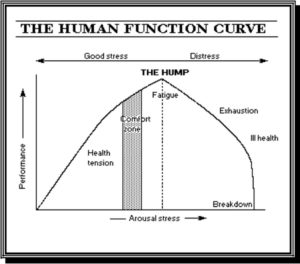73% of Australian workers are affected by workplace stress*.
91% of workers’ compensation claims involving a mental health condition are linked to workplace stress**.
What is Workplace Stress?
Workplace Stress results from a discrepancy between the requirements of a role, an individual’s capabilities to undertake that role, and the resources and support available to them in the workplace (1). Of course, some degree of stress will always be present at a workplace, especially in response to commonplace pressures such as deadlines, challenging tasks or performance reviews. Stress is commonly viewed as a negative thing; however, in the right amount, workplace stress can actually motivate your workers and enhance their productivity and performance.
Eustress vs Distress: Is workplace stress good or bad for productivity?
As illustrated in the graph (2), a moderate amount of stress is actually beneficial for productivity. Indeed, with too little stress, workers tend to be less concerned about their performance and are unlikely to be motivated at work – resulting in apathy and complacency. Mild stress hence encourages the highest productivity; the rush of adrenaline that we experience in response to stress helps us to perform tasks quickly under impending deadlines, perform well during busy periods, and think on our feet (3). Too much stress, on the other hand, can lead to exhaustion, burnout, and health problems.
Accordingly, psychologists have distinguished between positive and negative stress (4). The short-term experience of stress in which the gap between demands and available resources are slightly pushed, but not overwhelmed, is termed ‘eustress’. Eustress results in motivation, focus, energy, feels exciting and improves performance. ‘Distress’, on the other hand, occurs when the demands are perceived as outside of one’s capabilities, and results in a lack of motivation, burnout, decreased performance, and can lead to mental and physical health problems. Eustress is beneficial for driving performance, whilst distress is likely to produce more mistakes, poor time management, inter-employee conflict, impairments in memory and focus, and absenteeism.
Making the Most of Work Stress
If stress can boost productivity and performance, how can we harness stress and use it to our advantage? Here are some techniques:
Set deadlines
Deadlines encourage a pressure for tasks to be completed efficiently, without which a worker may be dwelling on the same project for a long time. Importantly, these deadlines need to be realistic; unreasonable deadlines can cause overwhelming pressure that may impede performance.
Expand responsibilities
Work that is considered too easy or monotonous can lead to boredom and complacency that hinders productivity. A sense of challenge that comes with novel work and new responsibilities can revive interest in work and boost productivity.
Develop a positive mindset
The impact of job stress also depends on the way in which stress is interpreted (5). When faced with a challenging task, those with a higher perceived ability to carry out that task (self-efficacy) are more likely to experience eustress rather than distress (6). Further, those who can recognise stress and anxiety, and use it to regulate their performance, are less likely to have stress negatively affect their performance (3).
Organisations can support their staff to make the most of work stress by providing training to boost self-efficacy, equip employees with strategies to recognise, use and manage stress, and encourage positive reinterpretation of stressful situations. Staff training courses, such as our workshops in Mindfulness and Wellbeing, Building Resilience, and Time Management, could vastly improve how staff interpret and manage workplace stress.
How much stress is too much stress?
Signs that an employee might be suffering from (bad) stress include: panic/anxiety, muscle tension, headaches, poor sleep, and irritability. Factors such as long hours (including working through breaks and taking work home), limited autonomy over work, lack of support from managers and co-workers, and job insecurity are more likely to contribute to extreme and chronic stress. Employers can support stressed employees by:
- * Providing a space for employees to take breaks
- * Encouraging personal leave when needed
- * Fostering a culture of open communication
- * Providing training in Mindfulness and Wellbeing, Mental Health Awareness, or Resilience
- * Making support services available, such as an Employee Assistance Program.
References
** https://www.safeworkaustralia.gov.au/safety-topic/managing-health-and-safety/mental-health
- https://www.headsup.org.au/healthy-workplaces/workplace-stressors
- Nixon P (1979) Stress Response Curve.
- https://www.headsup.org.au/training-and-resources/news/2015/11/04/the-real-cost-of-workplace-stress
- Lazarus, R. S. (1966). Psychological Stress and the Coping Process. New York, Toronto, London: McGraw-Hill Book Co.
- https://www.medibank.com.au/Client/Documents/Pdfs/The-Cost-of-Workplace-Stress.pdf
- https://raijmronlineresearch.files.wordpress.com/2017/06/4_12-15-sivasubramanian.pdf











